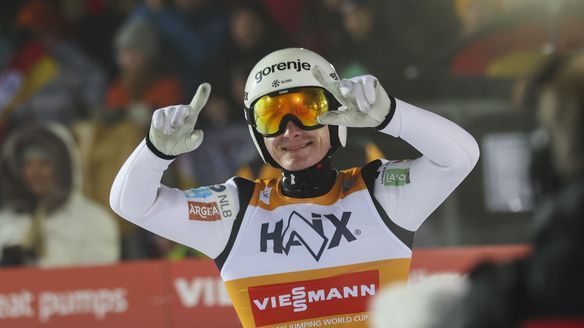Daniel Tschofenig explains differences between summer and winter Ski Jumping
Aug 08, 2025·Ski Jumping)
Ski Jumping’s summer series, the FIS Grand Prix, gets underway in Courchevel (FRA) this weekend. While the summer discipline is similar in many ways to the winter standard, there are pronounced differences between the two.
The search for a warm-weather equivalent to ice in-runs and snow landing areas took several years. Then in 1954, the East German coach Hans Renner came up with the idea of covering matting with plastic fibers. When sprayed with water, this surface gives a ‘slide’ comparable to that of snow.
This plastic matting was initially used on the in-runs and landing areas, but experimentation continued on the former. Whereas ice in-runs now boast cooling systems to ensure a smooth surface even in relatively mild winter conditions, summer competitions predominately use ceramic in-run tracks with integrated water sprinklers to keep the surface wet and slippery.
As for competing on ceramic and plastic, who better than reigning men’s FIS World Cup champion Daniel Tschofenig to explain how it differs from winter Ski Jumping?
“You can definitely feel that the takeoff is different on a ceramic track,” says the Austrian star. “There’s also less variation due to weather compared to ice tracks, which can change a lot depending on sun, cold, snow, or even rain. That makes things more challenging in winter. On ice, you really need to be a more complete jumper with as much experience as possible.
“Ceramic tracks have been part of my Ski Jumping life from the very beginning. In summer, they’re an essential part of our training routine. I've always felt comfortable on them, even though the feeling isn’t quite the same as on ice tracks in winter.”
Tschofenig is among the athletes taking part in the FIS Grand Prix, and he is relishing meeting his rivals for the first time since clinching his first overall World Cup triumph at the end of March.
“I'm really looking forward to it, especially the Olympic test event in Predazzo,” he admitted. “And, of course, our home competition in Hinzenbach. It’s great to have the whole Ski Jumping circuit together again. And that feeling of competition is something you really miss during the summer months.”
The main focus of the season is, of course, the Olympic Winter Games Milano Cortina 2026. Preparations for the Games will soon begin in earnest with the Grand Prix playing its part, not least because of the introduction of new regulations and sanctions surrounding equipment.
“The summer competitions are still very important for us,” insists Tschofenig, “Even though this phase of professional Ski Jumping is currently going through some major changes.
“With the winter calendar becoming more packed every year and the ongoing developments in equipment, it's time to adapt the summer season accordingly. An Olympic test event like the one in Predazzo this year is obviously ideal as the perfect preparation for the big stage.”
The FIS Grand Prix comprises six rounds (five for the women), with the series ending in Klingenthal (GER) on October 26. The FIS World Cup gets underway in Lillehammer (NOR) four weeks later on November 22.

)
)

